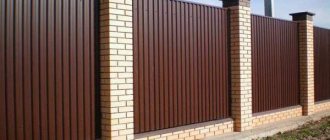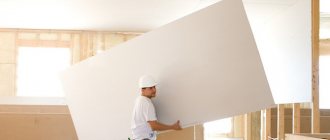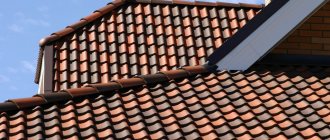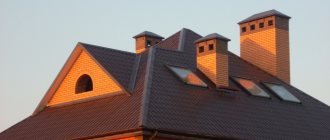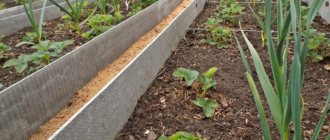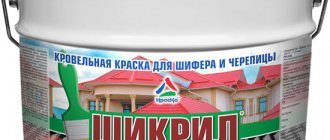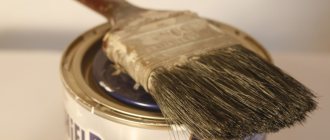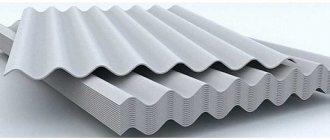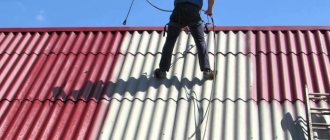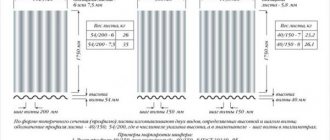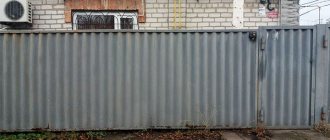A little about slate
Both wave and flat slates are produced using the same technology, which is based on a molding composition consisting of:
- Portland cement grade M300-500, which acts as a binding element. It is present in the solution from 80 to 90% of the total mass.
- Chrysolite-asbestos in the form of a reinforcing frame, the volume of which in the solution is 10-20%.
- Water.
Traditionally, slate is a gray material. Today, many manufacturers, adding dyes to the molding mixture, offer material of different colors. The slate itself is attached to the frame system using special nails with a wide head. The sheets are mounted on the roof overlapping each other, usually offset by one wave.
Not everyone knows that today manufacturers offer roofing elements made from asbestos-cement composition. These are skates and connecting parts. Therefore, most often on roofs you can see these elements made of steel sheet. And this worsens the appearance of the roof structure.
Slate of different colors Source olestnicah.ru
Manufacturing Basics
The raw material used is pulp, which includes asbestos, glass, paper fiber, water, cement, and dye. In special mixers, the composition is thoroughly mixed and fed in small portions into a press, which removes excess water and sends the workpiece to the molding shop.
There, under pressure, it takes the shape of a wavy sheet and is cut to the required size. The finished semi-finished product is placed in small bundles through metal sheets, which give it a smooth surface and a clear wavy surface.
The bags are sent to the drying chamber, where the product gains the necessary strength and enters the disassembly machine. There the metal gaskets are removed for further cleaning and lubrication. Then the sheets are moved to a warm room, where final hardening and strength gain occur within 7 days. After this, the slate is sent to the finished product warehouse.
About the sizes of slate sheets
So, let's move on to the main topic: slate - sheet sizes. Note that modern wave slate has three varieties, which differ from each other in the number of waves. There are 6, 7 or 8 of them. According to GOST, all three varieties are available in two sizes:
- The height of the wave is 40 mm, its length is 150 mm. This slate is designated as 40/150.
- And 54/200.
There is a classification according to profile type. It includes three types.
Unified
The material is marked as “UV”. Here are clear sizes for each variety. Size of 8-wave slate:
- width – 1130 mm;
- length – 1750 mm;
- thickness - 5.8 and 6-7.5 mm, the first for the 40/150 profile, the second for the 54/200 profile.
Size of 7-wave slate:
- width – 980 mm;
- length – 1750 mm;
- thickness - 5.8 for profile 40/150 and 6-7.5 mm for 54/200.
Slate size in 6 waves:
- width – 1125 mm;
- length 1750 mm;
- thickness - the same as previous models.
Sizes of slate sheets depending on the profile and number of waves Source info-krovlya.ru
See also: Catalog of projects of houses with a hip and half-hip roof
Ordinary
This type of wave material is designated “VO”. Here are the same dimensions for all profiles. Namely: width 680 mm, length 1120 mm, thickness the same as in the “unified” category.
GOST allows minor errors in dimensions.
Reinforced
This variety is labeled as “VU”. It got its name only because it has a large sheet thickness - 8 mm. The remaining dimensions are standard for all profiles. Namely: width 1000 mm, length 2600 mm.
GOST does not prohibit deviations from parameters. But there are strict limitations on the errors themselves: in length - ±15 mm, in width - no more than 10 mm in the larger direction, and no more than 5 mm in the smaller direction.
Reinforced slate with thick wall Source krovlyakryshi.ru
Use as a roof
Advantages
Wave slate has the following advantages:
- Mechanical strength . The combination of a cement binder with asbestos or fiber filler gives roofing sheets significant mechanical strength. In any case, with a fairly modest thickness (up to 8 mm), you can walk on the laid slate.
The roof is quite durable
- Thermal conductivity. The structure of the material ensures its low thermal conductivity. Of course, it cannot be used as a full-fledged heat insulator, but in hot weather the roof will heat up much less than a metal one.
- Resistant to moisture and corrosion . This ensures the composition of the slate.
- Lifetime . A properly installed roof will last at least 20-25 years. Moreover, if one sheet of roofing material is damaged, it can be simply replaced without redoing the entire roof.
Even an old slate roof serves quite effectively
- The material is not flammable . In addition, when burned, slate does not emit toxic substances.
And yet, the main advantage is the reasonable cost of the products: if you are looking for ways to minimize the cost of roofing work, then the choice will be quite obvious.
Flaws
This building material also has a number of disadvantages:
- Fragility. This is the main operational drawback, which is due to insufficient elasticity. Sheets can crack both during transportation and during processing, which increases the percentage of defects.
It is not difficult to make a hole in the coating, so you need to work carefully
Hence the obvious conclusion: when buying slate, you need to make a larger reserve than in the case of other roofing materials.
- Weight. Asbestos-cement sheets, especially reinforced ones, weigh a lot (from 23 to 35 kg). And if you take into account the significant dimensions of the product, then the problem with climbing to the roof becomes obvious.
If possible, you should use equipment to lift
- Porosity. The porous surface of the material absorbs rain and melt water, which significantly reduces its service life. With temperature changes, this can lead to cracking of the sheet, but usually everything is limited to gradual overgrowth with moss. To avoid this, it is necessary to treat the slate with special compounds containing an antiseptic.
The photo shows how far moss growth can go.
- Interaction with fire . Slate does not ignite, but during a fire it cracks intensively. Flying fragments can cause injury or fire in neighboring buildings.
And yet, the main disadvantage of this material is its potential carcinogenicity, due to the presence of asbestos in the slate composition. This question is quite extensive, so I will devote a separate section to it.
A few words about toxicity
The degree of danger of asbestos-cement slate depends on which mineral in the composition is used as a filler. There are two options here:
Chrysotile asbestos - less dangerous
- Chrysotile asbestos is used in the production of roofing materials in the USA, China, Russia, Ukraine, Belarus and other countries. Alkali-resistant, but susceptible to acids.
- Amphibole asbestos – previously used in production in Europe. Resistant to acid, but reacts with the alkaline environment of cement mortar.
Amphibole asbestos is an active carcinogen.
This is precisely the root of the problem:
- The point of view about the high carcinogenicity of slate containing asbestos was formed in Europe. And it is absolutely fair: amphibole materials really cause cancer, and there is no way to compensate for the harm from them.
- Chrihsotile asbestos, used in the production of domestic building and roofing materials, can also be carcinogenic. But its activity is much lower, so negative consequences can only occur if used incorrectly.
Slate based on amphibole asbestos is being abandoned all over the world
- Research shows that asbestos-containing slate can be used for roofing work, provided that the premises are reliably isolated from chrysotile dust. But it is undesirable to use flat sheets for internal cladding.
Thus, if you buy slate in Moscow or another city in the Russian Federation, then most likely there is no need to worry. Of course, it is better to clarify the composition of the material and the origin of the raw materials, but still, the danger of an asbestos-containing roof is, to put it mildly, exaggerated.
Slate sheet weight
It is clear that the larger the dimensional parameters of the roofing material, the greater its weight. And the last characteristic plays an important role in construction. This is especially true for roofing materials, which require a strong and reliable foundation.
And since a rafter system is formed under the slate, how to assemble it, and from what quantity of materials, you must first of all know the weight of the slate used to cover the roof. This characteristic depends on how many waves are in the sheet and on the thickness of the material.
For example, how much does a slate sheet with a 40/150 profile weigh:
- 7-wave – 23.2 kg;
- 8-wave – 26.1 kg.
With profile 54/200: 26 and 35 kg, respectively.
There is one more weight parameter that is indicated in the tables. This is the weight of one square meter of roofing material. So, for example, it is 10.41 kg for an eight-wave sheet.
Why do you need to know the weight of slate sheets? As already mentioned, it’s all about the costs of the roof truss system. After all, slate itself is one of the heaviest roofing materials. In addition, the weight of snow and rain is added to it. It should be added that for large roof areas, even the absorption of water from precipitation is taken into account, because slate absorbs it well.
Slate sheet weight Source aquagroup.ru
Substitution of the concept
Since asbestos-cement sheets have been popular for a long time, marketers are using a trick. They use the name slate for new roofing products, giving the materials similar names.
Currently, soft slate has become in demand among consumers. It has the following qualities: beautiful appearance, long service life and easy installation. One of its main advantages is its light weight, which simplifies transportation and operation.
This product has nothing to do with the original slate. It is also called bitumen roofing or ondulin. Soft slate is produced from cellulose or mineral fibers, which are impregnated with highly purified bitumen.
Metal slate is a sheet of steel with a wavy profile. Most often, roofing made from this material can be seen in shops and industrial enterprises. This material is inexpensive. Painted sheets of metal slate are used for arranging roofs on residential buildings. This roofing coating received its name due to the fact that it has an external resemblance to asbestos-cement slate.
Another modern material for roofing is plastic. Such slate is used for the construction of simple structures - greenhouses, greenhouses, gazebos, terraces, etc. Plastic coating has many advantages, including strength, lightness, and easy operation.
Transparent slate gives buildings a special atmosphere; it allows you to grow plants in the winter garden. What this type of coating has in common with asbestos-cement sheets is the presence of a wavy profile.
Useful coverage area
The technology for installing slate on a roof is to lay it overlapping relative to each other. In this case, the overlap can be done in one or two waves. It is clear that this will reduce the area covered by the sheets.
In essence, it turns out that the usable area is the total area of the sheet reduced by the overlap area. There is no need to count anything; there are tabular data that you can use. For example, for ordinary slate sheets, the usable area is:
- 7-wave – 1,336 m²;
- 8-wave – 1.57 m².
These indicators correspond to single-wave overlap. By the way, this is the technology most often used in construction.
Slate overlap in two waves Source krysha-expert.ru
No. 4. Euroslate
Having abandoned asbestos-cement slate, European countries switched to using euro-slate. It is otherwise also called bitumen or soft slate . The material appeared in our construction stores not so long ago, but customers have already managed to appreciate its advantages. Euro slate is made on the basis of cellulose fibers , which are impregnated with special polymer substances, after which the material is pressed under the influence of bitumen vapor at high pressure and temperature, and after drying it is painted in the desired color. Bitumen allows you to create an absolutely waterproof material.
Euroslate is represented by the following types :
Ondulin is produced on the basis of cellulose, rubber, bitumen, dyes and mineral components. The result is light, soft and flexible sheets;- Nulin is also plastic, durable and has a wave profile, but is slightly heavier than ondulin and has a longer service life;
- Gutta is strikingly different from other types of bitumen slate. In its manufacture, organic fibers are used to reinforce sheets of material. Special impregnations are used to increase rigidity and strength. Gutta is usually used for roofing industrial buildings; this material is cheaper than other types of bitumen slate, but is not inferior to them in its basic properties.
advantages are common to all types of Euro slate :
lightness, sheets of bitumen slate can even be laid on top of the old roof;- flexibility;
- strength. The material easily withstands significant wind and snow loads;
- durability. Service life reaches 50 years;
- excellent waterproofing properties. The material does not allow or absorb moisture;
- high level of sound insulation. When raindrops hit the roof, this noise will not be heard in the house.
some drawbacks :
- insufficient resistance to low and high temperatures. In summer, the material can soften, and in winter it becomes excessively brittle;
- low resistance to ultraviolet rays, so faded spots may appear on the surface of the slate;
- relatively high price.
Flat slate
Now let's look at the dimensions of flat slate. Let's start with the fact that the flat version of this roofing material is presented in two types on the market: pressed and non-pressed. The first differs from the second in increased strength, so slabs with larger sizes are produced from it.
But GOST does not indicate this. This document simply indicates the dimensional parameters. Here they are:
- slab length sizes: 1500, 1750, 2000, 2500, 3000, 3600 mm;
- width sizes: 1000, 1130, 1200 and 1500 mm;
- thickness varies in the range of 6-30 mm, but the most popular panels are 6.8 and 10 mm thick.
We must pay tribute to the manufacturers who today are ready to produce flat slates of any size, meaning non-standard ones.
Attention! If construction requires large slabs, then it is better to give preference to the pressed type.
The dangers of asbestos cement
In the first 10-15 years after production, the slabs do not pose any risk to people . Then, under the influence of moisture and temperature changes, their surface begins to collapse . Many small cracks form, from which a cloud of invisible but extremely dangerous fibers emerges.
Their harm is as follows:
- A carcinogen destroys the structure of cells and causes diseases such as cancer of the lungs, larynx and ovaries. According to statistics, those working in the asbestos production sector suffer from cancer 10-12 times more often.
- The smallest particles cut into the mucous membrane of the respiratory tract , causing irritation, itching, and coughing attacks.
Slate dust is not harmful to plants, but animals and insects can be seriously harmed by it.
Video description
In this video, watch the process of cleaning and painting the roof:
Caring for plastic sheets involves periodically getting rid of dust.
Metal sheets (corrugated sheets) also lose color. Paint with alkyd enamel on metal.
- Step 3. All repair, restoration, and decorative work will be entrusted to specialists with permission, the necessary tools and a wealth of knowledge, experience and skill. When receiving an application, the first thing they will do is ask what the slate is made of in order to determine the scope of work.
Broken: application
A building material such as slate can be used not only to decorate the roof, but also as decoration. There are quite a few options for using broken slate, each of which is original in its own way. When repairs are done with your own hands, it is possible to turn the most extraordinary ideas into reality using these products.
Pieces of slate are often used to frame flower beds and beds. They are buried in the ground, creating a kind of fence. Various flower arrangements, complemented by plaster sculptures, look very beautiful and original in this design. Small slate pieces can be used to lay out neat paths in the garden or yard. In addition, crushed waste is perfect for filling ditches and holes.
Old and damaged sheets will become the optimal basis for the construction of foundation formwork. Such designs are practically not inferior in quality to options made from boards, so they are an excellent alternative to more expensive materials.
Many gardeners use broken slate to protect plants from cold and rodents. To do this, the tree trunk is fenced with pieces of slate, which are fixed with wire or rope.
With a little imagination, you can come up with a lot of interesting options for using broken slate. If there are minor cracks on the sheets, they can easily be repaired using a special grout with an antiseptic. This approach allows you to restore old slate, restoring the appearance of the entire roof.
physical and chemical indicators
The most important technical characteristics of flat slate, on which its durability and application possibilities depend, are strength, density, viscosity, and frost resistance.
Flat slabs are characterized by high bending strength, which allows them to be used in the construction of ceilings, floors, roofing, and foundation walls. Unpressed products withstand bending forces of 18 MPa, pressed ones - 23 MPa.
The density of flat slate is relatively small and is equal to 1600 kg/m3 for LNP, and 1800 kg/m3 for LPP. This means that the thermal insulation properties of the material, on the contrary, are quite high.
Impact strength is a value indicating the ability of a material to resist impact loads. For pressed sheets, this parameter must be at least 2.5 kJ/m2, for non-pressed sheets - at least 2 kJ/m2.
Another important parameter is frost resistance. Unpressed slate can withstand 25 freeze-thaw cycles, and pressed slate - 50. As a rule, these figures are very close to the actual service life of asbestos-cement sheets.
Color solutions
Modern technologies make it possible to produce slate in almost any color range. Among the range of these products presented on the world market, there is both regular gray material and colored material. It is worth noting that only the outer side of the sheets can be painted, and the process itself is carried out using special paint based on acrylic and vinyl. This colorful composition allows you to create reliable protection against fading, thanks to which the slate perfectly retains its original color.
In order to increase the level of water resistance, the sheets are coated with a bitumen layer on the inside.
Slate roofing material can be painted blue, green, red, brown or another shade. In addition, it can be characterized not only by a bright color, but also by a more subdued one. If necessary, you can always paint ordinary gray slate yourself in one color or another using special rubber paint.
An applied layer of such paint will not only visually embellish the roof, but will also significantly extend its service life, protecting it from premature destruction. This feature should definitely be taken into account during the selection process.
Assembling the sheathing
When performing roofing work, the sheets are laid on the sheathing. For slate it is made sparse. Corrugated sheets are strong enough to avoid using solid plywood or OSB sheathing. They can easily support a person's weight. The lathing is nailed to the rafters in increments of 40-70 cm. It is made from bars 40x40 mm or 50x50 mm.
When using boards instead of bars, the lathing is made on 3 supports. A board is laid on the edges of the sheet and one is fixed in the center. The use of unedged boards instead of timber allows you to save slightly on the purchase of lumber, while the resistance of the sheets to mechanical pressure does not decrease. The sheathing must be fastened at right angles to the rafters so that when the slate is nailed, the nail heads look straight. In addition, distortion may result in a lack of support for attaching the outer sheets.
Additional lathing is made around the chimney to attach the edges of the slate to it. It should be located 130 mm from the pipe so that the wooden elements do not catch fire from the heat emanating from it. If you plan only to install a thin chimney, then reinforcement with timber around the perimeter is not used.
